PROGEDO presents: The Hanseatic City of Hamburg
Before relocating to Hamburg, you might want to know what to expect. PROGEDO has compiled a few facts about the beautiful Hanseatic city for you.
The Free and Hanseatic City of Hamburg
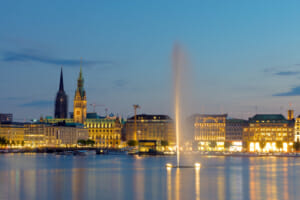
The Free and Hanseatic City of Hamburg, with more than 1.7 million inhabitants is the second largest city and also a state of the Federal Republic of Germany. Hamburg is located in Northern Germany at the confluence of the Alster and the Bille into the Elbe and is divided into seven areas with a total of 104 districts.
The total area is 755 km2 (60 km2 of water). The city stretches from north to south and from west to east over a distance of 40 km. Striking points are the Harburg mountains with the highest point (116 meters above sea level. NN), the Elbe, which flows from east to west through the city center, and the Fuhlsbüttel airport to the north.
The A1 and A7 motorways run through the city. A special feature is the Alster, which was dammed in the city center to form an artificial lake, and divides into the larger outer Alster and the smaller Binnenalster, enclosed by the historical center of the city.
The Truth about „Schietwetter“
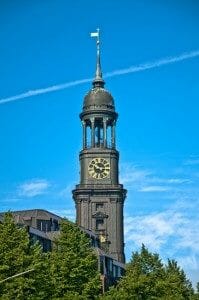
Hamburg’s climate is influenced by the geographic proximity to the North and Baltic Seas and Scandinavia. An almost ever-present breeze ensures fresh air and makes hot summer days more bearable.
The famous Hamburger “Schietwetter (what means “shit weather”) with drizzle and cold wind doesn’t happen very often according to statistics. During the year an average of 760 mm of precipitation falls, which is not among the highest values compared to other regions in Germany.
The average temperature in January is around 1 ° C, in April 8.1, in July and in October 17.4 and 10.4 degrees Celsius. With 1522 hours of sunshine a year (34% of total possible hours) Hamburg is however not particularly spoiled by the sun.
Traditional Hanseatic City and Modern Metropolis
Hamburg is one of Europe’s oldest republics and has a more than 1,200-year old history. The Hanseatic city is one of the most important economic and industrial sites in Germany and is an important service and commercial center.
After the opening of the border, Hamburg became even more important as an international trade center and connecting link to the Eastern European countries. Hamburg holds a leading position in the fields of aviation, shipping, media, science and research.

Container ship cranes at Hamburg Harbor, Germany,,,
A landmark of Hamburg is the third largest port in Europe (one of the main transport harbours in the world). In addition, Hamburg also has the third largest aviation industry worldwide after Seattle and Toulouse. Hamburg shares with New York the title of the largest diplomatic center in the world because of its high number of consulates.
Maritime Influences and Abundant Greenery
Hamburg offers a high standard of living. Many parks, green spaces and bodies of water make Hamburg a city of nature. This has a very positive effect on the quality of life in the north German metropolis.
Even the North and Baltic Seas can be reached in an hour by car. The Lüneburger Heide and the neighboring federal state of Mecklenburg-Vorpommern with many lakes and nature reserves are among the finest and most attractive recreational areas in Germany.
Recreation in Hamburg
The Hamburg cultural and arts scene is world-renowned. Even gourmets are satisfied in the many top class restaurants. Endless shopping and the vibrant party scene round off the leisure time.
The Mönckeberg street, a pedestrian street that runs from Central Station to the Town Hall Square offers great shopping opportunities. Slightly more exclusive is the famous Jungfernstieg and its side streets with many exclusive boutiques
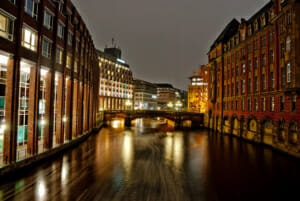
beautiful night cityscape with mooving water
On the southwest side of the Alster there’s a great place in the small but splendid shopping mall “Alsterarkaden” which is nice even in the rain. In Eppendorfer Baum you can stroll in an architecturally pleasant environment. Tuesdays and Fridays you should not miss strolling through the most beautiful farmer’s market in Hamburg Ise street.
It’s hard to describe the varied pubs and night life of the city. As for restaurants, the “Restaurant Report” is especially recommended, since it is based on guest reviews.
Successful musicals, the German Schauspielhaus or the Deichtorhallen offer entertainment for everyone. A true tourist attraction is the Reeperbahn – the central street in the entertainment and red-light district of St. Pauli with many famous discos and pubs as Schmidts Tivoli or Thalia Theater.
Property in Hamburg
The real estate market in Hamburg, as with many other cities, should, be regarded under different aspects. The following describes the situation in popular neighborhoods that particularly interests PROGEDO customers.
Some of the best residential areas next to the Hafen City include the areas around the Alster lake, the western districts. However, they are not cheap. Hamburg is one of the cities with the highest rent prices in the whole of Germany. The supply of large, luxury apartments is much lower than the demand, especially in the popular “Elbe suburbs” (Blankenese, Nienstedten, Klein and Gross-Flottbek and Othmarschen). Good properties are rented “cold” for about 14-18 Euros per m2. Many ex-pat managers want to live with their families near the international school in Othmarschen, which increases the demand dramatically. Larger apartments are a rare commodity – they rent for about 13-15 Euros m2 cold. Conclusion: those who want to have their family in a quiet, yet still central area, should look at the districts mentioned above, assuming you have the financial resources. Those on a tighter budget, wanting to live in this corner of Hamburg, will turn to the neighboring districts Osdorf and Bahrenfeld. Rental prices are significantly lower in this area. That condition also applies to Lokstedt with its French school as well as Schenefeld, Halstenbek and Pinneberg. The latter, Pinneberg, which officially forms part of federal state Schleswig-Holstein, is the location of another International School, the ISC, which was established at the end of 2016. Especially the appealing study fees and considerably lower rental prices of the neighborhood make it a good alternative to the “Elbvororte” like Othmarschen, Groß-Flottbek, Nienstedten or Blankenese and its international school.
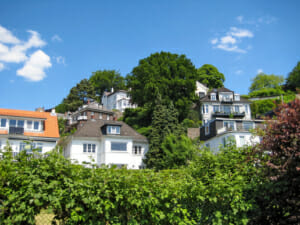
Blankenese, famous district, city of Hamburg, Germany
The parts of the city to the outer Alster really have a special flair. Singles and young couples would be happy living here. Rotherbaum and Harvestehude are amongst the most beautiful but also the most expensive areas and are rather quiet in contrast to the vibrant Eppendorf and Winterhude. Especially older buildings are rare and very expensive. Nicer apartments here rent from 12 euros per m2 cold. Many even cost, depending on location and amenities, 17 Euros or more per m2. Similar rates are found in Eppendorf, which has evolved from a trendy district to a coveted residential area for high-earners. Many pubs, bars and shops make the area particularly attractive and lively. Winterhude provides a similar atmosphere for slightly lower prices. A slightly quieter neighborhood is Uhlenhorst. The prices depend, like in St. Georg, greatly on the location. St. George, due to its proximity to the central station, battles with crime, but offers a special flair and is becoming increasingly popular especially among singles and young couples. Because of the high demand, it is not easy to find a small apartment in any of these locations around the Alster. Larger apartments are rare and houses for rent are virtually non-existant. In addition, all neighborhoods around the Alster have an acute parking shortage.
The very trendy districts of Eimsbüttel, Schanze, Ottensen, St. Pauli, and parts of Altona are especially popular among young people. You have your finger on the pulse here. Homes and the associated leases whether small or large, are ripped right out of the hands of the brokers and owners. A good apartment at 12 euro cold rent per square meter is hard to find, 13-15 Euros are the rule. And if it is a newly built apartment in a prime location you can expect to pay as much as 16 euros.
For families especially the northern parts of the city such as Poppenbüttel, Hummelsbüttel, Sasel or Volksdorf and the so-called “forest villages” (Wohldorf-Ohlstedt, Duvenstedt, Lemsahl-Mellingstedt, Bergstedt) are recommended. Rents range from about 9 to 16 Euro per m2. The downside is the long distance to the town center. Especially in the rush hours you have to expect 45-60 minutes by car.
An entirely new district, was created more than 10 years ago – the Hafen City. At one time one of the biggest construction sites in the world, the Hafen City has become an attractive, metropolitan residential district. Impressions:
By the mid-2020s there should be enough accommodation built to house up to 12,000 residents and provide up to 40,000 jobs on the site. The location between the Elbe and the center and the modern style make the apartments, especially in direct waterfront highly sought after and expensive. Rates of over € 20 per square meter are not uncommon here.
Also south of the Elbe there are quite attractive residential areas, many of them at very reasonable prices. However, the cost savings is only partly worthwhile due to the rather long and time-consuming trip to the center of Hamburg.
The most beautiful destinations for exploration tours in hamburg
When the first steps in the relocation process are taken care of, it is high time to explore the Free and Hanseatic City of Hamburg and its sights. Due to its rich and varied history, Hamburg boasts both modern Zeitgeist and time-honored traditions.
Hamburger Michel – St. Michael’s Church

Affectionately called “Hamburger Michel” or simply “Michel” by the locals, the Lutheran main church with its 132-meter-high steeple is one of the most famous landmarks of the city.
Built between 1750 and 1762, this most important specimen of protestant baroque architecture in Germany was destroyed and reconstructed several times during its history. After a devastating fire in 1906 and severe air-raid damage during World War II, the Michel was rebuilt as a faithful reconstruction of the original which allows us to enjoy its beauty and especially the breathtaking panoramic view from the observation gallery atop the spire even today.
You can explore the altar, pulpit, organs, pipe organs, and the history of the church either on your own or with a guide. Open from Mai through October from 9 a.m. to 7.30 p.m. and November through April from 10 a.m. to 5.30 p.m.
Elbphilharmonie
The Elbphilharmonie is Hamburg’s newest cultural landmark. Three concert halls, an entire hotel, the plaza with its stunning view across Hamburg from 37 meters above ground and 45 luxury apartments all rest on more than 1,700 reinforced concrete pillars planted firmly in the riverbed of the Elbe.
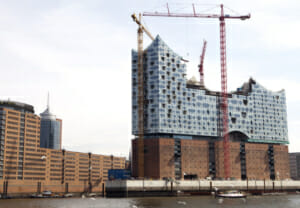
Construction site of the new Elbphilharmonie in Harbor City in Hamburg
Since 2007, it has been one of Europe’s most interesting and challenging building sites, partly because of its location and partly because of its groundbreaking architecture. Old and new combine in a unique synthesis reflecting the city, its harbor, and modern plate glass and classical brick architecture.
Located in the new waterfront district HafenCity, the concert hall rises to the considerable height of 110 meters. But it is most famous for its skyrocketing construction costs. Estimated in 2007 to run to a total of 114 million Euros, innumerable delays and unforeseen difficulties have inflated the total bill to a multiple of the initial sum. In December 2012, the Senate of Hamburg and building contractor HOCHTIEF finally agreed on a fixed price of 575 million Euros before taxes.
The Elbphilharmonie is now scheduled to open in early 2017 (originally 2010). However, you can already book guided tours to the construction site and even enjoy its spectacular acoustic in one of the rare concerts held in the partially finished building. Even now it is definitely worth a visit.
Funfair “Hamburger Dom”
Welcome to the biggest and longest funfair in the north of Germany! Spread out over 160,000 square metres (about 40 acres), more than 260 machines, sideshows, booths and food stalls come to town three times a year for a full month, making this travelling funfair with its regular firework displays, family afternoons and special events a semi-permanent institution not to be missed.
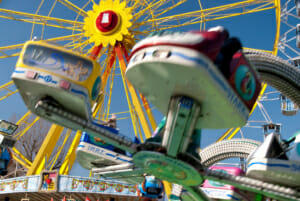
amusement park dom in hamburg
The fair that nowadays attracts roughly 2.8 million visitors per session traces its roots back to the 11thcentury AD. Back then, craftsmen and jugglers, merchants and hawkers sought protection from the elements – the infamous Hamburger Schietwetter – under the roof of the city’s St. Mary’s Cathedral (or Dom St. Marien in German) where they held regular fairs.
The archbishop of Bremen and Canon of Hamburg, Burchard Gelle, was not amused and in 1334 he had them tossed out. When he learned that all the good Christian churchgoers in town resented his decision, he allowed the fairs to resume in 1337 on condition that they would only be held inside the cathedral in inclement weather. And so the fair took place inside the church until the building had to be demolished in 1804.
Without a permanent location for the fair, the merchants and showmen dispersed across the market squares of the neighboring quarters like Gänsemarkt, Pferdemarkt, Großneumarkt, or Zeughausmarkt. In 1893, they were allotted a new site at the Heiligengeistfeld, where the Dom funfair is regularly being held until this day.
Miniatur Wunderland
Are you looking for a fun activity for the whole family? The world’s biggest, digitally controlled model railway is located right in the heart of Hamburg’s historical warehouse district Speicherstadt. With more than 1 1/2 acres of floor space and equipped with several snackbars, a cafeteria, play areas, and coloring boards for the little ones, the Miniatur Wunderland is sure to enthrall young and old.
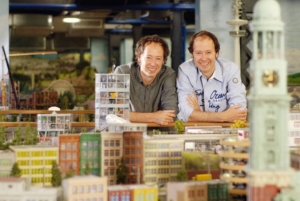
Every 15 minutes, a completely computer generated, splendid new day dawns for more than 160,000 figurines, 5,000 cars, 9,000 meters of tracks, 3,000 buildings and bridges, 1,000 signals, 250,000 lights, and 165,000 trees.
Visitors are explicitly invited to press the buttons and flick the switches to their hearts’ content. Interactive features are distributed along the length and breadth of the model railway layout and enable you to start funiculars, let windmills spin, and make crowds cheer in a soccer stadium.


